Note: this is Part 2. You can read about the first four days of the trip here.
| Day 5 – December 9 |
| Highland Beach |
| 0 miles |
This was my “zero” day to enjoy the beach. In the morning I headed out on my kayak around 7:30 to go for a morning fishing expedition. On the way to the inlet I saw a stingray jump two feet out of the water. I didn’t know rays could do that!
I had a great time fishing the mouth of the Rodgers and Broad rivers. I caught multiple speckled trout, ladyfish, and saltwater catfish. I had to be careful with the catfish (hardhead and gafftopsail) because they both have venomous barbs that can give you a nasty injury. Fortunately I managed to remove the hooks without getting stuck.
Around noon I caught a 16 inch trout. I decided that was my catch of the day and headed back to my camp on the beach. I spent the afternoon at camp, doing some chores like washing the debris off my boat, re-organizing my gear and food, and then relaxing and reading on the beach. Did you know that a Hobie kayak seat can be removed and used as a beach chair? Pretty sweet.
Late in the afternoon a group of four landed on the beach just south of me. Though I had seen one or two motorboats each day so far, these were the first kayakers I’d seen in the Everglades. They each had a Hobie kayak, like mine but 2 feet longer, with two outriggers and a sail. Can you still call that a kayak?
I decided I should go say hello. Hard to believe, but this was my first conversation in five days. I didn’t catch exactly what their route was, but I gathered that they had also started in Flamingo, and had gone up the coast, whereas I had stayed in the Waterway’s inside passage.
Returning to camp, I made up a small fire and cooked my fish. The pelicans must have moved on to a new fishing spot, because this time there was no diving show with my dinner.
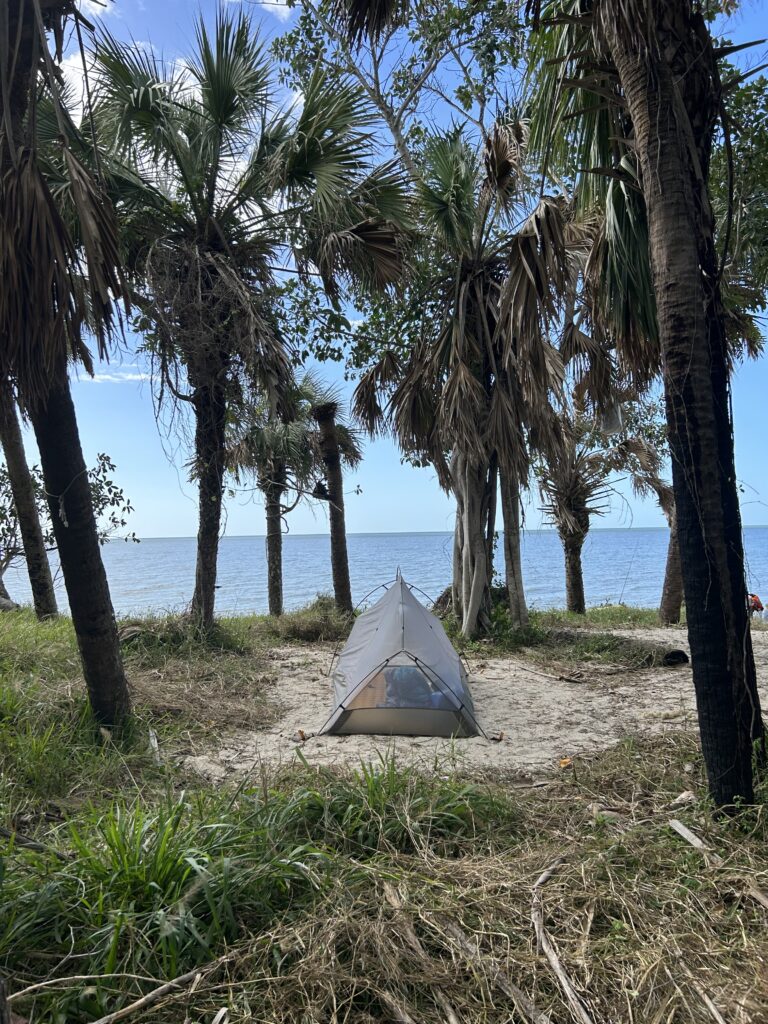
| Day 6 – December 10 |
| Highland Beach to Rodgers River Chickee |
| 14.5 miles |
I was excited to get back on my route after the day off and wanted to get an early start, but when I woke up around 6:30 I couldn’t see the water from my tent. The tide was so low that the shoreline had receded probably a half mile from where it had been the night before. What was left was a huge mudflat. Crap.
According to my tide chart, low tide was supposed to be at 9 am, but once again, that did not match reality. It was anyone’s guess how long I’d have to wait for the tide to come back in. However, I remembered that the day before launching from the beach at 7:30 was no problem, so I figured it couldn’t be too long to wait.
I decided to just start packing up and see what happened. Fortunately within minutes I could see the water was rising quickly, and by the time I was packed up, the mud flat was almost completely covered again. I killed a little extra time by drinking coffee on the beach and by the time I was ready to go, I only had to drag the boat through a few feet of mud. No big deal.
Leaving the Gulf, the water shoreline narrowed becoming the Broad River. Within half a mile of paddling up the Broad I saw a large motionless form on the muddy bank to my left. I thought it was maybe another alligator. As I got closer I pulled out my binoculars to get a better look. Staring back at me was a big, unmistakeable, toothy grin. Crocodile!
Crocodiles have a longer, more pointy snout than alligators and have large exposed overlapping teeth. Crocs also have grey bodies while gators look almost black. The Everglades are home to both alligators and crocodiles. In fact, the Everglades is the only place in the world where alligators and crocodiles coexist. Alligators prefer fresh water but can tolerate salty, whereas crocodiles prefer salty but can tolerate some fresh.
While American crocodiles are an endangered species, their numbers in the Everglades have been increasing in recent years due to conservation efforts and the Florida population has been reclassified as “threatened.” Even so, while gator sightings are quite common in the Everglades, seeing a crocodile remains a rare treat.
Though not as aggressive as their Australian or African relatives that are often demonized on TV, the American crocodile is more likely than an alligator to attack if threatened. I veered far to the right to give it as much space as I could, my heart rate raising a little.
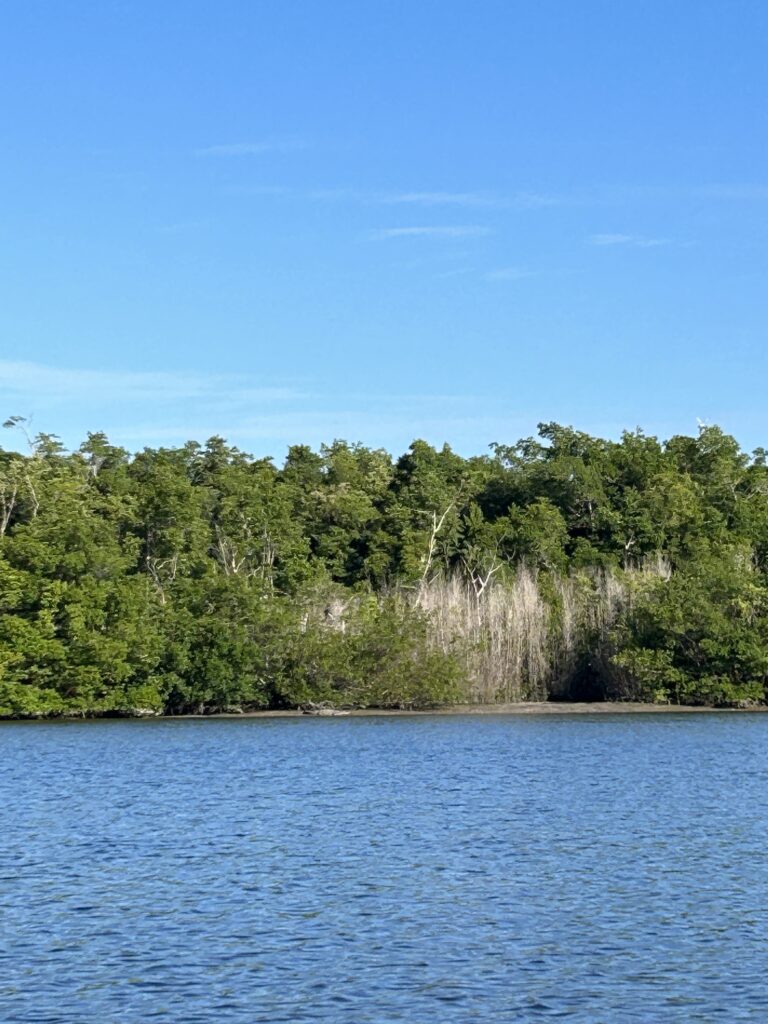
The very next minute I saw two gators swimming on the opposite bank. Here I was, the only place in the world where alligators and crocodiles coexist, and I had a crocodile on my left and two alligators on my right.
The wildlife spotting didn’t stop there. The next mile or so on the Broad River was a wildlife highway. I saw several additional alligators, and then two grey triangular fins poking out of the water. Seriously? Now there are sharks??
Continuing on I saw the vague outline of a large grey body just below the surface of the water. A big round head popped up and I heard a breathing noise. I think it was probably a manatee, but I didn’t get a good look. Knowing I was surrounded by crocodiles, alligators, and sharks (oh my!), I didn’t much feel like lingering.
From the Broad River I had to fight against heavy wind of Broad Bay before cutting north up the Johns River toward Rodgers River Chickee. After all the excitement that morning, at the chickee that night I couldn’t help but notice how quiet it was. I had become accustomed to the nightly symphony of splashes and wildlife sounds, but here it was silent. It was almost 7 pm and I hadn’t even yet been chased into my tent by the bugs. Where is everybody?
| Day 7 – December 11 |
| Rodgers River Chickee to Plate Creek Chickee |
| 13 miles |
Passing through several mangrove-lined bays, the day’s paddle was monotonous, and actually, a little bit boring. Similar to the night before, my surroundings did not seem as exploding with wildlife as they had early in the trip. (Though I did see two gators and two sharks in the afternoon).
It was hard to put my finger on what exactly was different, but there was a different vibe in the air since departing Highland Beach.
While fishing I caught a new species, a mangrove snapper. Retrieving the fish, I noticed that the water was colder than it was south of The Nightmare. I licked my finger. It did not taste salty.
I must have entered an entirely different ecosystem, I thought. It made sense. The Nightmare was the tenuous, barely there, passage between larger bodies of water and now I was in a new habitat.
The wind howled all night on Plate Creek Chickee. It was quite cold in the wind, so I had to get up to put on the tent’s rainfly. The rainfly kept the tent warmer, but was noisy. If you’ve never spent a night in a tent that is flapping in the wind, it is the absolute worst. Fortunately I had packed earplugs. With the combination of rainfly plus earplugs, I got a decent night’s sleep.
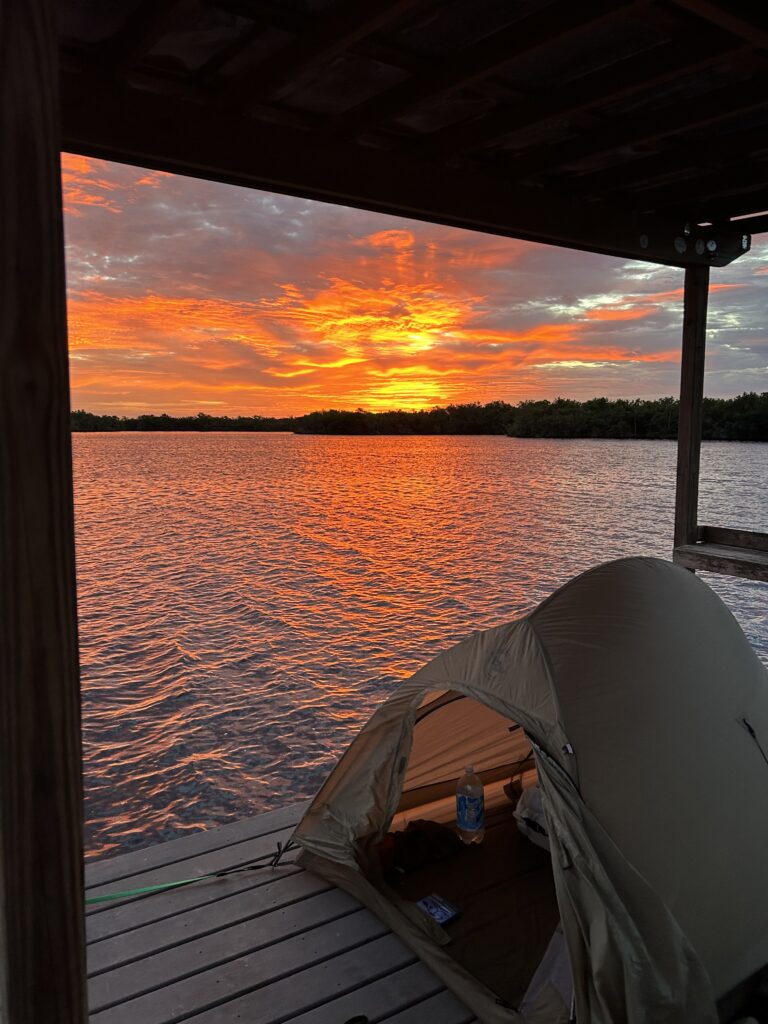
| Day 8 – December 12 |
| Plate Creek Chickee to Crooked Creek Chickee |
| 17 miles |
My longest day at 17 miles. I was pretty sore and tired at the end, though I think more from fighting the wind all day than from the length. I saw two gators while passing through small winding creeks. On the aptly named Alligator Creek I twice heard a loud crunching noise. It sounded exactly like my dog Shaggy eating his kibble. I peered into the mangrove branches to see what it was, but I didn’t see anything. My guess was it was raccoons crunching through oyster shells.
While setting up my tent on the chickee, two men in a canoe pulled up. I could hardly believe it. In eight days, I had never camped with anyone else. I had had the Waterway and the chickees entirely to myself. Though I would pass one or two motorboats each day, the only other paddlers I had seen was the group of four I had briefly met on Highland Beach.
They were a father and son from North Carolina on their first day of a three-night trip. As the sun set they became exasperated by the bugs, which made me feel less like a wimp. I had been tortured by no-see-ums all week. My solution had been to eat dinner early and retire to my tent to read before they came out at dusk.
I had eaten my dehydrated beans and already gone into my tent when they pulled out a cooler full of steaks, potatoes, and veggies to cook. Though I was happy to be guarded from the bugs, I had to smell their steak cooking. Torture!
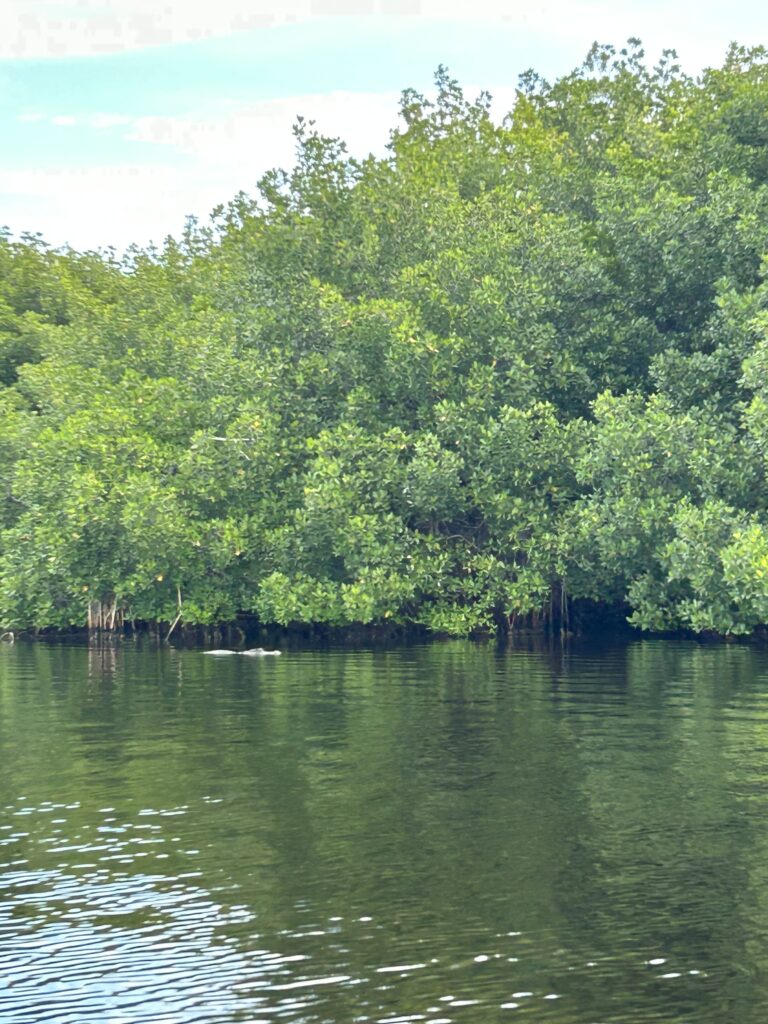
Once they had finished their dinner and the first wave of no-see-ums had subsided, I emerged from my tent and chatted with them for an hour or so. They were interested in my experience on the Waterway and about thru-hiking the Appalachian Trail. They confessed that between the bugs and the forecasted wind, they were considering quitting their trip the next day.
| Day 9 – December 13 |
| Crooked Creek Chickee to Everglades City |
| 8.5 miles |
I was paddling away from the chickee before the father and son were up. Cruising down the Lopez River was lovely and easy. I caught the most beautiful large speckled trout while trolling. It felt like a nice send off.
Upon entering the Choskoloskee Bay, it started to rain. I had my choice of two ways to go. I could cross the open bay to the left of Choskoloskee Island, or I could go to the right of the island and paddle up a canal. There were some dark clouds in the distance, and not knowing what the weather was going to do, I chose to head toward the more protected canal route.
It took a long time to get to the canal and as I approached the tide got lower and lower. By the time I was at the canal entrance I was in three inches of water and realized it wasn’t passable.
It started to look like a storm was coming. I could wait hours for the tide to rise, or I could go back around the other side of the island and attempt to cross the open bay. Either could be dangerous in stormy conditions, but I decided to make a run for it across the bay. If the weather got worse, I could hunker down on Chokoloskee and wait for the storm to pass and/or the tide to rise, but I hoped I wouldn’t have to. My car was waiting for me just on the other side.
The rain and wind picked up as I crossed the bay. At times the water was only a few inches deep but I was able to get through by hand paddling. The fins of the foot pedal drive stick out a foot from the bottom of the kayak, so in shallow water I have to use a traditional kayak paddle. Spoiled by my pedal drive, I’ve come to hate hand paddling, especially when it’s choppy and windy.
I thought of a duck. A duck appears totally calm and collected when paddling with its little feet under water. But now imagine a duck attempting to propel itself using only its wings. That’s how ridiculous I felt.
I struggled and got soaked, but I made it. The tide was still low when I pulled up to the boat ramp. As I stepped out of the kayak, I instantly sank up to my knees in quicksand-like mud. My feet were completely stuck. I pulled and pulled, but was unable to pull my feet out of the mud. My feet pulled out of my shoes which were suctioned deep into the mud. I had to abandon them and trudge out the last few steps barefoot.
The shoes were the last pair I had worn on the AT and were hanging on by a thread. Though they had already hiked well over 500 hundred miles, I brought them to the Everglades because I thought an old grubby pair of sneakers would be a good substitute for water shoes. It was their time to go and I left them to get sucked back into the earth. Caked in mud, I hobbled barefoot through the gravel parking lot to my car, where fortunately I had another pair of shoes.
I loaded up my car in the rain and began the drive back home to Virginia.

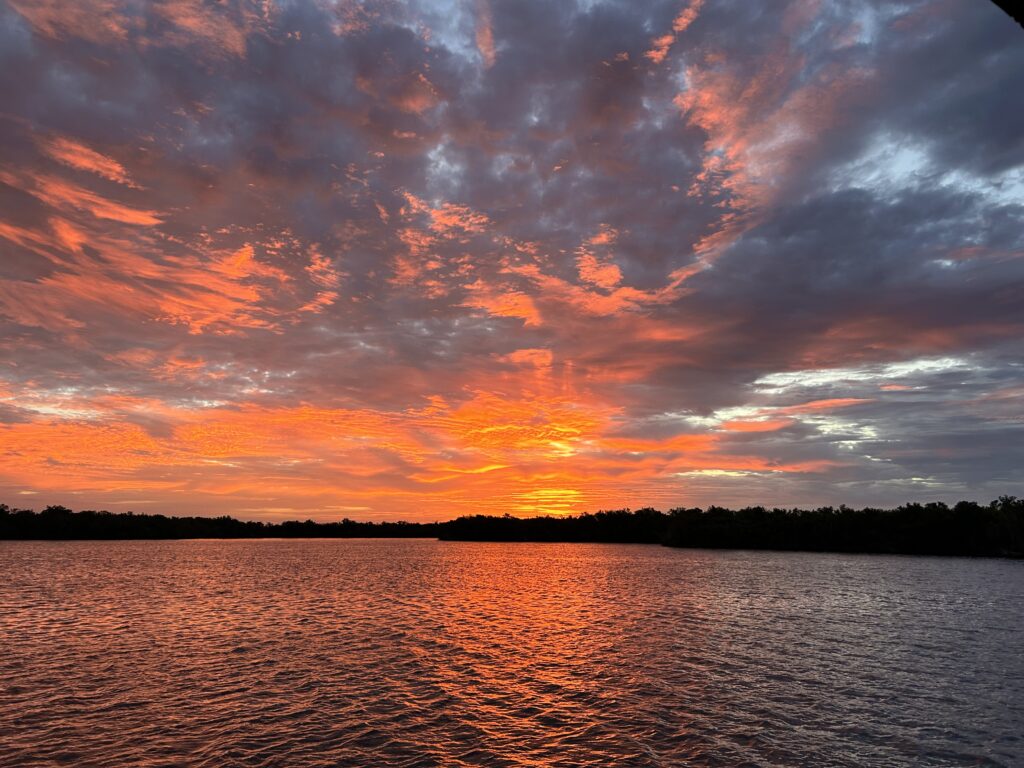
Beautiful sunsets! Thanks for letting everyone live vicareously (sp) through your very descriptive travels! You are so brave!
Thanks for reading! Glad you enjoyed it
Merry Christmas! I am totally impressed and thankful you made it!!
Thank you! Merry Belated Christmas!
Kirby, I love the more nature writing style the past few posts! It feels quite different from your AT posts. You really experienced some incredible life out there. SO COOL. And I’m really glad you didn’t die in the quicksand within sight of your car….
I’ve been thinking about your tide planning issues. It is a fact that tides get convoluted by complex shorelines (same thing happens in the fjords up here). The water takes time to move through/around all the squiggles on the map. The more complex the shoreline, the more the tide timetables can get distorted. I can imagine that may have been the problem amongst hundreds of miles of mangrove channels. Sounds like you handled it pretty well, taking careful observations as you went and adjusting as needed.
One time in Mexico I saw a shark fin… that quickly became THREE shark fins. Seemingly swimming in tandem, directly towards me. My heart was racing quite hard, because certainly the only reason sharks would start synchronized swimming was because they were planning a kayak attack. On the other hand, it didn’t quite add up. The three fins were SO synchronized… and eventually they all disappeared together before swimming under(?) my kayak. I did some research and decided it must have been an ocean sunfish swimming with its three fins sticking out of the water.
Thanks! Glad you enjoyed the trip log! and good point about the tides. I was expecting some tidal variation deep in the backcountry, but what surprised me the most was that even on beach of the Gulf Coast, it was still off. I guess even the coast could be affected by the matrix of rivers and channels?
Once or twice I thought I saw a shark fin, but I believe it was actually a tarpon. They sometimes swim with their forked tails sticking out of the water.